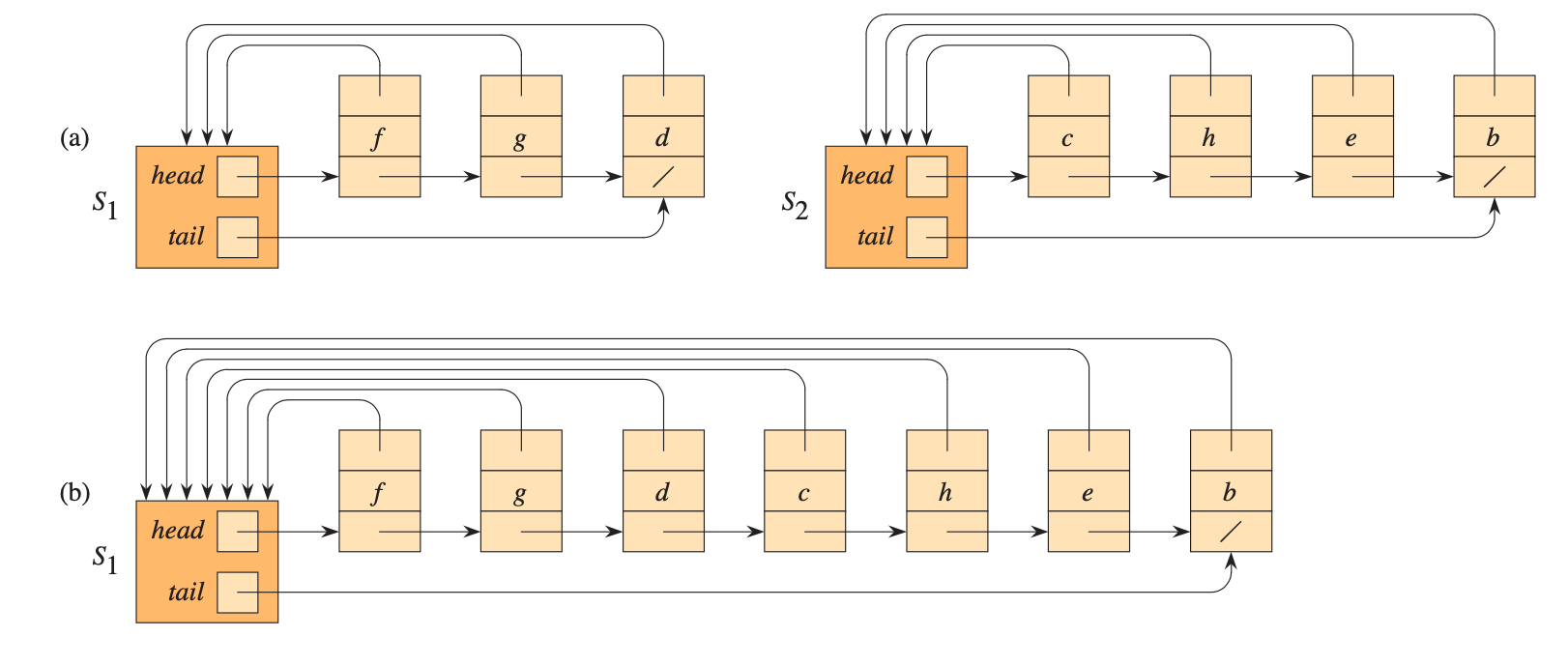Disjoint Set
Definition
一個disjoint set維護一個"collection" ,並且以其中一個member來當作representative。要由哪個member來當作representative依據情況而定,如果沒有特別指明的話,collection中的任一member都可以是representative。
Operations
Disjoint set支援三個operation:
- -: Create一個新的set with x。
- : Union兩個set,然後產生一個新set。新的set的
representative會是, 中的某個member。 - -: 給一個member ,返回含有的set的
representative。
Implementation
Linkedlist
一個簡單的做法就是用linked-list來表示一個set。如下圖,每個set由一個linked-list來儲存,representative node的兩個pointer (head, tail) 指向第一個element和最後一個element,每個node也有兩個pointer,一個指向representation node,另外一個指向下一個element。

Make-Set(x): create一個linked-list只需要常數時間,因此 time complexity =
Find-Set(x): 每個node都有一個pointer指向representative node,所以time complexity =
Union(x, y): 當merge兩個linked-list,我們會把其中一個linked-list併進去另外一個,然後更新被合併linked-list裡面所有的節點,把representative pointer指向新的representative node。在這個情況,我們希望被合併的linkded-list是比較短的一邊,這樣要更新的節點數目比較少。我們可以採用weighted-union heuristic的做法,也就是reprensentative node同時紀錄節點數目,在合併時長的list合併短的數目。Time complexity =
Theorem 1
Statement: Using the linked-list representation of disjoint sets and the weighted-union heuris- tic, a sequence of , , and operations, of which are operations, takes time.
Proof:
因為有個 的operation,所以最多也有個set,這個set的的operation的worst caset為每次merge都是差不多的長度,因此就是, , ...做merge,因此時間複雜度為。
而有M個和 operation,每個的time complexity為,因此為,因此全部的時間複雜度為。
Disjoint Forests
另外一種方式用tree來表示一個disjoint set,而這些disjoint sets就形成一個disjoint forest。
Make-Set(x): create一個tree只需要常數時間,因此 time complexity =
Find-Set(x): 每個node都有一個pointer指向parent,而representative指向自己,也就是root node,所��以time complexity = (tree是一條list)。
Union(x, y): 這種情況只需要把一個tree的root指向另一個tree的root,因此time complexity = 。
Union By Rank
如果要改善的performance,就是樹的height越低越好,其中一個做法就是在union的時候,將矮的樹merge進高的樹,也就是rank by height。要做到這點,就必須要在root儲存目前樹的height當rank。
Path Compression
Path compression的做法是在的時候,順便把路徑上的每個node的parent都指向root,也就是把此顆subtree攤平。
Time complexity
利用union by rank和path compression的技巧,我們能得到 時間複雜度為。而是一個成長非常緩慢的函數,且,因此可以視為,而是operation的數目。
Golang Implementation
disjointset.go
type DisjointSet struct {
Parent *DisjointSet
Rank int
}
func (set *DisjointSet) Find() *DisjointSet {
if set.Parent == set {
return set
}
// path compression
set.Parent = set.Parent.Find()
return set.Parent
}
func (set *DisjointSet) Union(another *DisjointSet) {
setRepresentative := set.Find()
anotherSetRepresentative := another.Find()
if setRepresntaetive.Rank <= anotherSetRepresentative.Rank {
setRepresentative.Parent = anotherSetRepresentative
// if the ranks tie, then anotherSetRrepresentative grows by 1 after merge
if setRepresntaetive.Rank == anotherSetRepresentative.Rank {
anotherSetRepresentative.Rank++
}
} else {
anotherSetRepresentative.Parent = setRepresentative
}
}